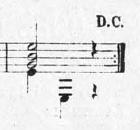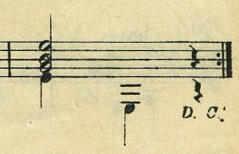Adelita by Francisco Tárrega
![]() Adelita is a charming mazurka written by
Francisco Tárrega that has been recorded by many famous
guitarists. Along with Capricho Árabe
and Recuerdos
de la Alhambra, it is one of his best-known
works. It is not clear, however, that it qualifies as a
mazurka. Mazurkas are usually faster than
the Lento tempo Tárrega notated
for Adelita. That may account for why
most recordings are played at
an Andante or faster. That said,
before the widespread use of metronome
marks,[1] the intended beats per minute of a
particular tempo indicator was ambiguous at best. Tárrega could
well have intended the tempo to be faster than what we today
conceive of as Lento. Therefore,
you may choose to play the piece faster than the
60 bpm I've listed, opting for a faster
80–90 in the Andante
range.
Adelita is a charming mazurka written by
Francisco Tárrega that has been recorded by many famous
guitarists. Along with Capricho Árabe
and Recuerdos
de la Alhambra, it is one of his best-known
works. It is not clear, however, that it qualifies as a
mazurka. Mazurkas are usually faster than
the Lento tempo Tárrega notated
for Adelita. That may account for why
most recordings are played at
an Andante or faster. That said,
before the widespread use of metronome
marks,[1] the intended beats per minute of a
particular tempo indicator was ambiguous at best. Tárrega could
well have intended the tempo to be faster than what we today
conceive of as Lento. Therefore,
you may choose to play the piece faster than the
60 bpm I've listed, opting for a faster
80–90 in the Andante
range.
Adelita is deceptively simple. If you are a novice guitarist, you may feel it is within your reach based on hearing the first half of the song. Even if you've mastered barres, upon reaching measures 11 and 12, you may reach an impasse. Playing the slurs fluidly requires a well-developed little finger. Therefore, I recommend not trying to learn the piece until you've developed both comfort with barres and sufficient strength and flexibility in the little finger to play clear hammer-ons and pull-offs.
Notation Changes and Commentary
I used the 1902 Antich y Tena edition of Adelita as the source for my edition. The Antich y Tena edition more than likely represents most closely what Tárrega notated. After much debate, I decided to make significant notational changes that do not change the meaning of the music, but make it easier for the contemporary player to understand. At first, the primary change I made was to extend the slurs from the acciaccaturas[2] to the note following the acciaccatura (forming a so-called reverse or inverted mordent). There's little doubt that is the meaning Tárrega intended, but strictly literal reading of the music today would cause a performer to strike the note after the acciaccatura (and, in fact, I've seen guitarists do this) instead of slurring it as part of a pull-off. After the fact, I consulted a 1923 edition from the Argentine publication La Guitarra (No.2, Dec. 1923) by Juan Carlos Anido,[3] and found the same clarification made.[4]
Acciaccaturas and Portamentos
After much thought, I decided that the accents on the notes after the acciaccaturas were too confusing for players without much notational experience. I had heard at least two mistakes made with respect to playing the piece. The first was to play the acciaccatura notes before the second voice bass note and accenting the note that showed the accent instead of accenting the beat. You're supposed to play the acciaccatura as part of the same beat as the second voice bass note, not ahead of it. It's easier for inexperienced players to grasp this when there's one acciaccatura note, but it becomes fuzzy for them when there are two notes involved which can be confused for two sixteenth notes.
The second mistake I had heard was playing the portamentos—which are notated in the original as an unslurred slide to a grace note—by striking the end note twice instead of once. I resolved this at first by adding slurs to the glissando/portamento/slide lines. Even though I used that notation in Lágrima, I don't care for it. In contemporary guitar notation—at least in the non-classical world—there should be no need for a trailing grace note when the grace note's pitch is the same as that of the following note. An unslurred slide means you slide from the first note to the second and strike the second note upon arriving. A slurred slide means you slide from the first note to the second and do not strike the second note, allowing it to sound as a result of the slide. Of course, that notational convention was not used in Tárrega's time and an unslurred slide (at least to a grace note) meant the same as a slurred slide today. Still, today the classical guitar world cannot bring itself to use the term slide and much confusion abounds regarding the difference between glissandos, portamentos, and finger shifts.
In the end, I abandoned my changes and decided to eliminate all acciaccaturas and trailing grace notes. Instead of acciaccaturas forming reverse mordents, I unambiguosly represent the notes with their actual values so there is no question that they are played on the same beat as the second voice bass note. I prefer the acciaccatura notation because no one can or should play a 64th note exactly. The performer should have some flexibility as to how to play the ornament. Nevertheless, I opted for unambiguous clarity over interpretive freedom.
I also replaced the trailing grace note portamento representations with a modern-day unslurred slide. These are not guide finger indications. A guide finger indication is denoted by a line connecting the two identical fingering numbers of two consecutive notes and does not produce an audible slide effect. As a side note, I believe notated guide finger lines to be superfluous; it suffices to see that two consecutive notes use the same finger number. A slide is denoted by a line connecting the two noteheads and does produce an audible slide effect. Since the slides are not slurred, you strike the second note on arrival. If they were slurred, you would not strike the second note.
I believe these changes resulted in more compact, unambiguous, and easy to read music. If you have doubts about using my edition, please remember that my changes do not change the music as it sounds. Both notations produce the same sounding music, but mine should be easier to interpret correctly.
Hairpins
A change I made that could impact musical interpretation is the addition of explicit dynamic levels to the hairpins. I almost left out the hairpins because their interpretation was not entirely clear. They may not even refer to dynamic levels.
Fancisco Tárrega was a trained piano player. At the time of his education, the meaning of hairpins in the music he studied was different than today. Composers as varied as Haydn, Beethoven, Chopin, and Schubert used hairpins as agogic and voicing instructions instead of as dynamic intensity indicators, for which the written instructions crescendo and decrescendo as well as abbreviated dynamic markings were used instead (for more information see The Secret Life of Musical Notation, Roberto Poli, 2010). This is more than just a theory; it becomes quite clear when you read the music as originally notated and compare it to later editions which mistakenly edit the original notation.
The hairpins in the 1902 Antich y Tena edition of Adelita—faithfully preserved in the 1923 Anido edition, but butchered in modern editions—that follow the contours of the notes instead of being placed horizontally above or below the staff—and also lacking accompanying dynamic intensity markings—may represent agogic considerations and not dynamic intensity changes. Despite that possibility, I included them assuming they represented changes in dynamic intensity and added explicit intensity levels that were missing at the ends of the hairpins. That is, except for measure 14, where the Antich y Tena and Anido editions show the forte between the hairpins, but on the bottom of the staff while the hairpins are above the staff. The first hairpin appears redundant to the un poco crescendo instruction. At the very least, it gives an indication of the duration of the crescendo, even though that could have been accomplished with a dotted line.
D.C. vs. D.C. al Fine
You may notice that my edition implies an AABBAB structure instead of the AABBA structure you're used to hearing. I have no idea where the AABBA structure originated (perhaps a Segovia transcription?). Both the 1902 Antich y Tena and 1923 Anido editions clearly use D.C. in the final measure. Modern editions write D.C. al Fine with the Fine in measure 8 or rewrite the first 8 measures at the end of the piece. Unless a pre-1902 manuscript in Tárrega's hand uses D.C. al Fine, I believe this to be incorrect.
| 1902 Antich y Tena | 1923 Anido |
|---|---|

|

|
Although I have preserved the original D.C. instruction, I also have added senza replica to indicate one should ignore repeats, resulting in AABBAB instead of AABBAABB. By 1902, I believe the ahistorical convention of not playing repeats on a Da Capo became entrenched. Mozart, Beethoven, and other great composers expected their Da Capos to respect the playing of repeats unless accompanied by an additional instruction not to do so (see Beethoven's Century: Essays on Composers and Themes, Hugh McDonald, 2008). By the 20th century, however, the notion of avoiding repeats had become widespread. Therefore, I assume—perhaps incorrectly—the repeats were not meant to be observed.
| Sheet Music |
|---|
| Adelita.pdf |
[1] Incidentally M.M. began as an abbreviation for Maelzel's Metronome, after Johann Nepomuk Maelzel, whose metronome became popular in the early 19th century. Although he did not invent the metronome, he manufactured and sold what became the most popular model.
[2] Originally, acciaccatura did not refer to an ornament, but was instead a style of playing a chord on a keyboard, crushing the notes together. In the 19th century, the term was confused with the appoggiatura. What we call an acciaccatura today is really a short appoggiatura (see Music Notation, Second Edition, Gardner Read, 1979, Chapter 13).
[3] Juan Carlos Anido was the father of the famous guitarist María Luisa Anido who studied and performed with Miguel Llobet.
[4] There remains the (unlikely) possibility that the 1902 Antich y Tena edition intended for the acciaccaturas to be unaccented grace notes (which is exactly how they are notated, with the slur not connecting to the following note and with an accent on the following note), in which case they would be played before the beat. But in that case, everyone publishing and playing the piece since at least Juan Carlos Anido's 1923 edition has been doing it wrong.
